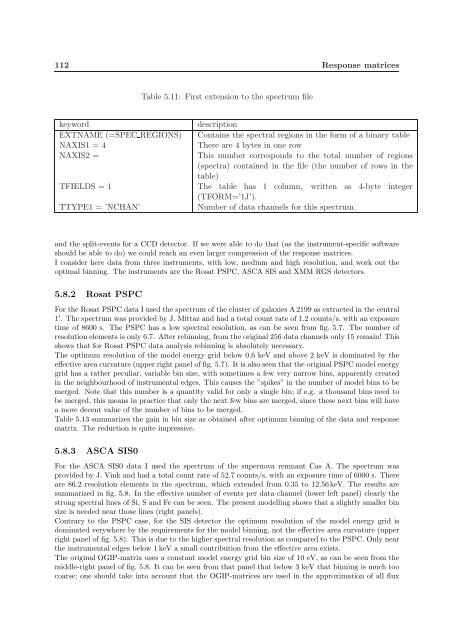SPEX User's Manual - SRON
SPEX User's Manual - SRON
SPEX User's Manual - SRON
Create successful ePaper yourself
Turn your PDF publications into a flip-book with our unique Google optimized e-Paper software.
112 Response matrices<br />
Table 5.11: First extension to the spectrum file<br />
keyword<br />
EXTNAME (=SPEC REGIONS)<br />
NAXIS1 = 4<br />
NAXIS2 =<br />
TFIELDS = 1<br />
TTYPE1 = ’NCHAN’<br />
description<br />
Contains the spectral regions in the form of a binary table<br />
There are 4 bytes in one row<br />
This number corresponds to the total number of regions<br />
(spectra) contained in the file (the number of rows in the<br />
table)<br />
The table has 1 column, written as 4-byte integer<br />
(TFORM=’1J’).<br />
Number of data channels for this spectrum.<br />
and the split-events for a CCD detector. If we were able to do that (as the instrument-specific software<br />
should be able to do) we could reach an even larger compression of the response matrices.<br />
I consider here data from three instruments, with low, medium and high resolution, and work out the<br />
optimal binning. The instruments are the Rosat PSPC, ASCA SIS and XMM RGS detectors.<br />
5.8.2 Rosat PSPC<br />
For the Rosat PSPC data I used the spectrum of the cluster of galaxies A2199 as extracted in the central<br />
1 ′ . The spectrum was provided by J. Mittaz and had a total count rate of 1.2 counts/s, with an exposure<br />
time of 8600 s. The PSPC has a low spectral resolution, as can be seen from fig. 5.7. The number of<br />
resolution elements is only 6.7. After rebinning, from the original 256 data channels only 15 remain! This<br />
shows that for Rosat PSPC data analysis rebinning is absolutely necessary.<br />
The optimum resolution of the model energy grid below 0.6 keV and above 2 keV is dominated by the<br />
effective area curvature (upper right panel of fig. 5.7). It is also seen that the original PSPC model energy<br />
grid has a rather peculiar, variable bin size, with sometimes a few very narrow bins, apparently created<br />
in the neighbourhood of instrumental edges. This causes the ”spikes” in the number of model bins to be<br />
merged. Note that this number is a quantity valid for only a single bin; if e.g. a thousand bins need to<br />
be merged, this means in practice that only the next few bins are merged, since these next bins will have<br />
a more decent value of the number of bins to be merged.<br />
Table 5.13 summarizes the gain in bin size as obtained after optimum binning of the data and response<br />
matrix. The reduction is quite impressive.<br />
5.8.3 ASCA SIS0<br />
For the ASCA SIS0 data I used the spectrum of the supernova remnant Cas A. The spectrum was<br />
provided by J. Vink and had a total count rate of 52.7 counts/s, with an exposure time of 6000 s. There<br />
are 86.2 resolution elements in the spectrum, which extended from 0.35 to 12.56keV. The results are<br />
summarized in fig. 5.8. In the effective number of events per data channel (lower left panel) clearly the<br />
strong spectral lines of Si, S and Fe can be seen. The present modelling shows that a slightly smaller bin<br />
size is needed near those lines (right panels).<br />
Contrary to the PSPC case, for the SIS detector the optimum resolution of the model energy grid is<br />
dominated verywhere by the requirements for the model binning, not the effective area curvature (upper<br />
right panel of fig. 5.8). This is due to the higher spectral resolution as compared to the PSPC. Only near<br />
the instrumental edges below 1 keV a small contribution from the effective area exists.<br />
The original OGIP-matrix uses a constant model energy grid bin size of 10 eV, as can be seen from the<br />
middle-right panel of fig. 5.8. It can be seen from that panel that below 3 keV that binning is much too<br />
coarse; one should take into account that the OGIP-matrices are used in the approximation of all flux

















